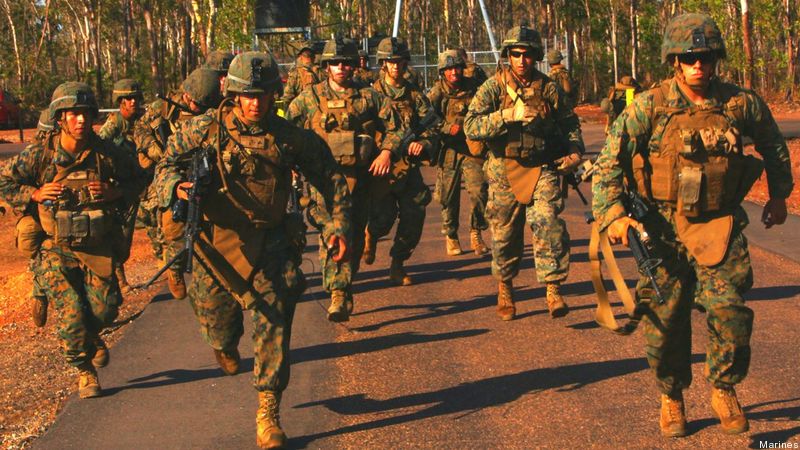
President Obama’s visit to Darwin, a port city, in Australia’s Northern Territories, celebrates 60 years of the ANZUS Treaty, centerpiece of one of the closest defense relationships on the planet.
Darwin is also the home of a forward Royal Australian Air Force base and other military facilities. Australian Prime Minister Julia Gillard and the president will highlight the coming of the U.S. Marines to a training facility in the territories. The visit could be the beginning of a strategic opening for Darwin in the 21st Century, built on the Marines facility and on the F-35.
In being a partner in flying the F-35 the RAAF is joining a fleet of aircraft –- F-35-As, -Bs, and -Cs, which can be deployed to Australia for training from bases in Singapore, South Korea, and Japan and from US ships and U.S. air bases across the Pacific. The entire allied team can draw upon Australian air modernization to shape new capabilities for Australia, and to diversify support for the F-35 multinational fleet.
Darwin’s location is excellent for such a base.
• From Darwin to the tip of South Korea is 3,000 miles–half way the great circle is over the Philippines
• From Darwin to Singapore is 2,000 miles
• From Darwin to Spratley Islands is 1.800 miles
• From Darwin to Hanian Island’s huge emerging PLAN sub base is 2,500 miles
• From Darwin to Jakarta is 1,800 miles
• From Darwin to Taiwan is 2,400 miles
For perspective, Pearl Harbor is 6,700 miles from both Singapore and Hanian Island and 4,500 miles to South Korea.
The RAAF can go from being on their forward deployed airfield to becoming a hub for the F-35 fleet in several ways.
First, given the significant commonality among the three types of F-35s, a significant logistics and support hub could be based in the Northern Territories. The differences among naval, Marine and air force aircraft are significantly blurred by the F-35s high degree of commonality. Based on the earnings that might be garnered from a logistics hub, the Aussies should be able to pay for a significant part of their own fleet modernization.
And a hub is not a permanent base. As an on-call service facility, the region’s allies can draw upon support when they are working with the Aussies on regional security missions.
In addition to a possible F-35 maintenance and support center, Australia boasts the large territory necessary for Asian F-35 fleets to train. The F-35 is not a replacement tactical aircraft; it is a new flying combat system, which will need significant training territory for pilots to learn how to use all of its capabilities. As an aircraft, which has electronic warfare capabilities built in, training to do cyber and EW ops are important. As a fifth generation aircraft, the F-35s ability to engage “aggressors” and to “defeat” air defense assets requires significant territory over which to operate as well. Instrumented training ranges over Australia and the contiguous ocean would be invaluable for building the necessary skills to deter any aggressor.
Thirdly, the F-35 is a significant ISR asset. The Aussies can build ISR collection facilities, which can leverage the entire allied FLEET of F-35s operating in a regional security setting. They can use such facilities to shape an approach to link other allied ISR assets to establish a “honeycomb” network or grid along the Pacific Rim.
Such an Australian hub could be a key element in shaping a new Pacific strategy. For the U.S. and its allies crafting a scalable force, one which can leverage one another’s assets across the vast expanses of the Pacific, is crucial. Since no platform fights alone, an allied FLEET of F-35s is a key lynchpin for shaping such a scalable force.
And by shaping a mix of hubs and bases, a honeycomb of force capability could be built for US and allied forces. Diversifying the location of hubs, facilities and bases is crucial not only for the US but its allies and partners. Looking at how to leverage new systems to enhance diversification is a key opportunity to deal with the multiplicity of threats in the Pacific and reduce the capability of an aggressor to concentrate force.
Building a hub at Darwin is in the interest of the Aussies, Asian allies and the United States, as all of the core players shape a Pacific strategy appropriate to the 21st century. And
it will help amortize the cost of the acquisition of the F-35 by Australia as well as to support modernization of C4ISR capabilities as well.
Robbin Laird, a member of the AOL Board of Contributors, is an international defense consultant, owner of Second Line of Defense website and a former National Security Council staffer. Ed Timperlake, the co-author, is a former U.S. Marine who works with Laird.
 President Obama’s visit to Darwin, a port city, in Australia’s Northern Territories, celebrates 60 years of the ANZUS Treaty, centerpiece of one of the closest defense relationships on the planet.
President Obama’s visit to Darwin, a port city, in Australia’s Northern Territories, celebrates 60 years of the ANZUS Treaty, centerpiece of one of the closest defense relationships on the planet.


























